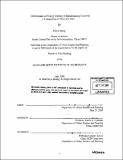| dc.contributor.advisor | Karen R. Polenske. | en_US |
| dc.contributor.author | Huang, Feiya | en_US |
| dc.contributor.other | Massachusetts Institute of Technology. Dept. of Urban Studies and Planning. | en_US |
| dc.coverage.spatial | a-cc--- a-ii--- | en_US |
| dc.date.accessioned | 2007-07-18T13:00:38Z | |
| dc.date.available | 2007-07-18T13:00:38Z | |
| dc.date.copyright | 2006 | en_US |
| dc.date.issued | 2006 | en_US |
| dc.identifier.uri | http://hdl.handle.net/1721.1/37871 | |
| dc.description | Thesis (M.C.P.)--Massachusetts Institute of Technology, Dept. of Urban Studies and Planning, 2006. | en_US |
| dc.description | Includes bibliographical references (p. 72-73). | en_US |
| dc.description.abstract | The amount of final energy per unit of economic output (usually in terms of gross domestic product, or GDP), known as energy intensity, is often used to measure the effectiveness of energy use and the consumption patterns of different economies. China and India are both developing countries with large population and rapid economic growth. China has decreased its energy intensity by 67% from 1978 to 2003; while India only decreased its energy intensity by 5% over the same period. By applying shift-share analysis on each country's industry sector, I decompose their changes of industrial energy intensity into two factors: structural change and efficiency change; then, I explore the determining factors of energy intensity in China and India, and analyze why they are different. The result shows that, in China, the driving force of energy-intensity change is the improvement of energy efficiency, which decreases the energy intensity. Meanwhile, structural-mix changes played a low, but positive, role in decreasing the energy intensity. In India, energy efficiency also plays a positive role. | en_US |
| dc.description.abstract | (cont.) However, the industrial structure has become more energy-intensive because of the increasing share of energy-intensive sub-sectors, which offsets the impact of energy efficiency on energy intensity; thus, the overall energy intensity only decreased slightly in India over time. | en_US |
| dc.description.statementofresponsibility | by Feiya Huang. | en_US |
| dc.format.extent | 78 p. | en_US |
| dc.language.iso | eng | en_US |
| dc.publisher | Massachusetts Institute of Technology | en_US |
| dc.rights | M.I.T. theses are protected by copyright. They may be viewed from this source for any purpose, but reproduction or distribution in any format is prohibited without written permission. See provided URL for inquiries about permission. | en_US |
| dc.rights.uri | http://dspace.mit.edu/handle/1721.1/7582 | |
| dc.subject | Urban Studies and Planning. | en_US |
| dc.title | Determinants of energy intensity in industrialized countries : a comparison of China and India | en_US |
| dc.type | Thesis | en_US |
| dc.description.degree | M.C.P. | en_US |
| dc.contributor.department | Massachusetts Institute of Technology. Department of Urban Studies and Planning | |
| dc.identifier.oclc | 124068267 | en_US |
